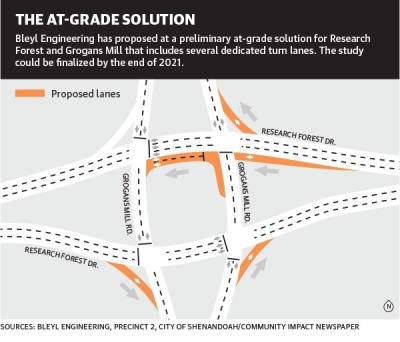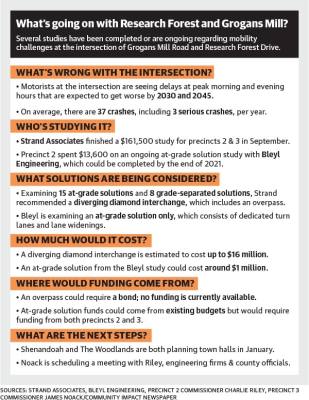The proposed solution was presented to Shenandoah City Council on Nov. 17 by Montgomery County Precinct 2 Commissioner Charlie Riley and John Bleyl, president and CEO of Bleyl Engineering. The proposal shows multiple dedicated turn lanes at the intersection, located in The Woodlands just outside Shenandoah. Riley said the project could help traffic move more efficiently.
“Moving lanes of traffic is where they’re making their ... right turns or their left turns,” he said in an interview. “So get them out of those moving lanes.”
Riley said he approached Bleyl to conduct the $13,600 study for an at-grade project after the results of a study by engineering firm Strand Associates were presented in April. The $161,500 Strand study was funded by precincts 2 and 3 and recommended a diverging diamond interchange—which would include an overpass and could cost up to nearly $16 million, according to the study.
Riley and Precinct 3 Commissioner James Noack said there is no available funding or support for an overpass. In addition to the proposed at-grade solution being cheaper—Riley estimates the at-grade solution could cost upward of $1 million—Riley said the project could be funded and completed sooner rather than later.
“We could make things happen and get it on the ground right now and make life a whole lot better for everybody involved,” he said.
He said county officials and Bleyl continue to “tweak” the study, which could be completed by the end of 2021 with a groundbreaking early next year and completion by the end of 2022. However, an analysis of Bleyl’s proposal by Strand as well as funding needs from Precinct 3 could prevent it from becoming a reality.
Potentially viable solution
Riley said he does not need county approval and likely would not need funding outside his own budget for his portion of the project. But some of the proposed improvements at the intersection—located on the border between precincts 2 and 3—would require funding from Noack’s office.
Following a review of Bleyl’s preliminary at-grade solution by Strand Associates emailed to Noack’s office Dec. 2, Noack said via email he would not support the current proposal because it “would provide negligible improvements in mobility and safety to the intersection.”
“Based on Strand’s review, the expansion alternative proposed would result in negligible changes in mobility, operations and system reliability, while creating additional conflict points and increasing opportunities for crashes,” the Strand email stated.
In the original Strand study—presented to both commissioners, Shenandoah and The Woodlands in April and completed in September—Strand determined the overall intersection was operating at a C level of service at morning peak hours and D levels in peak evening hours. The level of service measures delay times for motorists at intersections that range from A to F. The level of service could decline to a D in both morning and evening hours by 2030 and to an E at peak evening hours by 2045, the Strand study stated. An E service level is considered the limit of acceptable delay, but some communities establish their limit at a D, according to the study.
The Strand study also cited safety concerns due to the number of conflict points, stating it averages about 37 crashes per year, including three serious crashes.
At the Nov. 17 meeting, Riley and Bleyl said the at-grade solution could improve the future level of service to four B levels of service and one A at different intersection points by 2030 as well as five Bs by 2045. However, in the Dec. 2 letter, Strand engineers claimed the proposed at-grade solution would result in a 150% increase in the number of conflict points at the intersection.
Community input
Despite Strand’s original recommendation that the diverging diamond interchange was the best solution for the intersection’s issues, residents and community leaders said they oppose an overpass there. Shenandoah and The Woodlands both signed resolutions in June in opposition to an overpass following Strand’s meeting in April.
Residents have also expressed consistent opposition to a grade separation there with multiple residents speaking out at public meetings of Shenandoah City Council and The Woodlands Township board of directors in November.
Tyson Breedlove, who has lived near the intersection for two years, spoke at both meetings. He is among a group of residents organizing against a grade separation, joining a grassroots effort to get 1,000 signatures opposing an underpass or overpass. As of press time, the petition had 822 signatures. Breedlove said residents have protested a grade separation before, most recently in 2018.
“We don’t want our neighborhoods to be urbanized, and we feel like it would increase the noise; it would destroy the trees and green space; and it could ... put some of the nearby businesses out of business,” he said in an interview.
Township Chair Gordy Bunch said years ago the county came to The Woodlands and Shenandoah requesting support for a Houston-Galveston Area Council grant for a grade separation, but residents opposed it.
“I don’t see the township’s position changing unless the position of the community changes,” he said.
Bunch said the township met with Riley and Bleyl over the summer, but the at-grade solution has yet to be presented to the township board. The township and Shenandoah are planning to hold town halls on the at-grade proposal sometime in January.
As Bleyl and Riley continue tweaking the proposal, Noack said Precinct 3 completed some at-grade improvements at the intersection in the fall, including adding signal heads for each lane, installing signage and updating signal timing.
Noack said he has reached out to Riley, Bleyl, Strand, Montgomery County Traffic Engineer Rick Wong and county Traffic Operations Director Charles Cobb to request a meeting regarding the intersection.
“The best path is to continue working toward a solution that meets the safety and mobility needs of the intersection ... while also ensuring that a majority of interested entities and residents support such a project,” Noack said in an email.







